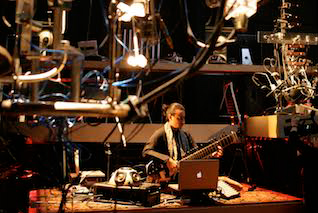An Asian Perspective to Design: How we use Technology to enable Musical Expression

Abstract:
With advances in algorithms for sound synthesis and processing, combined with inexpensive computational hardware and sensors, we can now easily build new types of musical instruments, and other real-time interactive expressive devices. These new ‘‘instruments’’ can leverage and extend the expertise of virtuoso performers, expand the palette of sounds available to composers, and encourage new ideas and composition techniques. This talk will look at a variety of new devices, projects, and ensembles created over the last decade, with a particular emphasis on extending techniques inspired by Asian music. From India, Korea, Indonesia, and beyond, the creation of new musical interfaces and robots will be presented. The birth of the KarmetiK Machine Orchestra evolved from these inventions, and video of compositions and experimental productions will be presented.
Bio:
Ajay Kapur is currently the Director of the Music Technology program (MTIID) at the California Institute of the Arts, as well as the Associate Dean for Research and Development in Digital Arts. He also runs a PhD Research Group in Wellington New Zealand called Sonic Engineering Lab for Creative Technology. He is also Founder and CEO of Kadenze, the Creative Arts MOOC. He received an Interdisciplinary Ph.D. in 2007 from University of Victoria combining computer science, electrical engineering, mechanical engineering, music and psychology with a focus on intelligent music systems and media technology. Ajay graduated with a Bachelor of Science in Engineering and Computer Science from Princeton University in 2002.
Kapur has published over 100 technical papers and presented lectures across the world on music technology, human computer interface for artists, robotics for making sound, and modern digital orchestras. His first book “Digitizing North Indian Music”, discusses how sensors, machine learning and robotics are used to extend and preserve traditional techniques of Indian Classical music. His latest book "Introduction to Programming for Musicians and Digital Artists" is a textbook for artists to learn computer science.